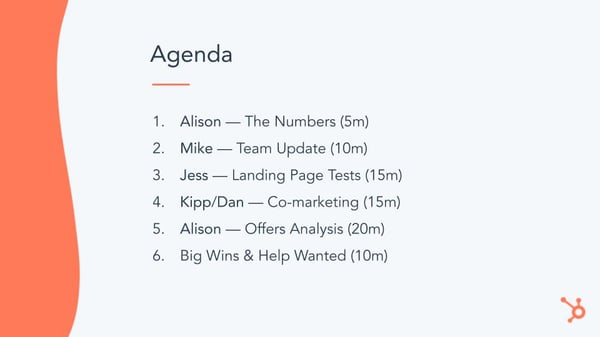- Like
- SHARE
- Digg
- Del
- Tumblr
- VKontakte
- Flattr
- Buffer
- Love This
- Save
- Odnoklassniki
- Meneame
- Blogger
- Amazon
- Yahoo Mail
- Gmail
- AOL
- Newsvine
- HackerNews
- Evernote
- MySpace
- Mail.ru
- Viadeo
- Line
- Comments
- Yummly
- SMS
- Viber
- Telegram
- JOIN
- Skype
- Facebook Messenger
- Kakao
- LiveJournal
- Yammer
- Edgar
- Fintel
- Mix
- Instapaper
- Copy Link
Meetings suck. They’re time for people to avoid doing actual work, stare blankly at each other, throw in generic comments to look like they’re paying attention, and if you’re lucky, maybe come out with some wicked notebook doodles.
Is that how people perceive your marketing meetings? I hope not, because they don’t actually have to be that way.
Turn your marketing meetings into something useful by — you guessed it — creating compelling content! (Oh my gosh, inbound marketing concepts work in real life, too!)
As your team grows, it’s important for everyone to get in a room together and talk about what they’ve been working on in their corner of the world. So to ensure those marketing meetings aren’t blocks of time your team dreads, make note of these tips for how to make marketing team meetings truly useful for your employees.
How to Run an Effective Meeting
While this post will primarily focus on marketing meetings, I want to address a team-agnostic section about effective meetings as a whole.
As I said above, meetings can be a grandiose waste of time. It’s tempting to run your work by others, gather feedback or affirmation, or simply avoid the tough stuff by calling meetings.
I’m here to tell you — don’t do it. The first step to running effective meetings is to only schedule meetings when absolutely necessary.
Quarterly meetings to report on company progress and important news? Of course. Monthly meetings to touch base on KPIs and recruit help for projects? Sounds great. Weekly meetings to report on current responsibilities and asks? I’m torn on whether this one is necessary, but for large teams or teams with new employees, this could be a good move.
Every moment in a meeting is time away from heads-down work, the work that arguably moves your business forward. Are meetings necessary to take a break, touch base, and rally with your team? Of course.
Secondly, to understand the effectiveness and efficiency of a meeting, ask your team. Ask, “is [meeting] helpful for you? If so, what are its top two benefits for you?” This can help you understand what percentage of your teams finds value in your meetings and what components or agenda items may be able to be removed to save time.
Speaking of agendas, let’s discuss next what your marketing meeting agendas should resemble.
Marketing Meeting Agenda
Whether your marketing team meeting is weekly monthly, this section will explain the content you should every single time. We also recommend creating a slide deck that you project for your team in each meeting so you can all follow along with each agenda item.
Marketing Meeting Agenda Example
For every meeting, you should have a dedicated agenda slide that lays out three things:
- What will be discussed in today’s meeting
- Who will be leading each discussion
- How much time is allotted for each discussion
Take a look at one of our recent marketing team meeting agenda slides:

Outlining who is talking, what they’re covering, and how much time they have to discuss it will help prevent the meeting from getting derailed. It will also prevent people from delving into unproductive conversations that are best had at another time and place.
As for what components should be on your marketing meeting agenda, let’s discuss what to cover during your marketing meeting.
Review Important Metrics
Do a quick review of your most important marketing metrics. These shouldn’t be niche metrics, like email unsubscribe rate, social media reach, or blog subscriber growth; save those for your monthly meetings where you review month-over-month progress.
These should be the metrics your marketing team is measured on. In other words, at the end of the month, what metrics will tell you whether the marketing team succeeded?
While every business will likely review something different depending on their business model, here are some ideas for you:
- Leads waterfall
- Sales waterfall
- Volume of marketing qualified leads(MQLs)
- Paid vs. organic leads breakdown
- Website traffic
It’s important to review your team’s important metrics because these are how you’re measured onas an overall marketing team. And if you don’t all know how you’re faring as the month progresses, individual contributors can’t do anything to step up and help your team’s numbers improve.
A Bit of Education
Marketing meetings should be a healthy mix of state-of-the-union content and educational content. Each week, have a couple team members present briefly about interesting projects they’ve been working on. This serves two purposes: it lets people know what their team members do all day, and they get to learn something new!
Think about it … wouldn’t it be interesting for a blogger to learn a little bit about a PPC experiment? Or for a social media intern to learn about the results of the latest email A/B test?
Sharing lessons from projects helps everyone expand their knowledge base, sidestep landmines if a project backfired, and implement effective new techniques that they never knew worked.
Boom — everyone leaves your weekly meeting a smarter, better marketer!
The Nitty Gritty Retrospective
Your meeting should also contain a review of the projects each employee (or if you’re a larger marketing department, each team) worked on last month/quarter/year, plus the results they’ve seen.
This is good for a few reasons. First, it keeps everyone accountable knowing that each meeting they need to stand up in front of their colleagues and explain just what they do all day. Second, everyone gets to learn from what everyone else worked on and become generally better marketers. Third, it helps everyone identify how individual teams are faring, and what projects they’re doing to improve their own metrics.
For example, if you have a social media team, this is their opportunity to report on the success of every single social network they manage. How is their reach faring? How much traffic are those networks sending to your site? How many leads are being generated? Why are some networks more successful than others?
While your weekly meetings (if you have them) may focus on more high-level, team-based metrics, a monthly or quarterly meeting is a good opportunity to do a deep dive into the channels and metrics that enable the entire team to meet its goals.
How You’ll Meet This Month’s Goals
After the retrospective, each employee or team should also present on their individual goals for the month or quarter, and how exactly they will meet those goals. This is not the time to be generic.
Teams should explain, point by point, everything they’ll be doing during the time period to meet the metrics they’re measured by.
For example, let’s say the email marketing team is responsible for driving more reconversions this month. What exactly will they do to, well, do that? Well, that slide might have some initiatives like A/B test email copy with and without a P.S., anoffers analysis to determine which offers convert at the highest rate, list segmentation experiments, tailoring lead generation offers to align more closely with personas to improve CTR … the list could, and should, go on.
This is also a critical time in your meeting for feedback. Build in time during every presentation — at least 5 minutes, more if you find you need it after a few meetings — for each team to solicit feedback on their proposed projects. This will help individual teams from getting derailed on projects that might not help them meet their goals, or perhaps other members of the marketing team have fantastic ideas that the teams hadn’t even thought of yet!
Big Wins
A little bit of recognition is a good thing. Set aside a couple of minutes — come on, you can’t find 5 minutes? — to showcase some of the amazing things your team members or department as a whole have accomplished.
This could be anything from press coverage, speaking engagements, engaging with power players on social media, a smash hit blog post, an email that received unprecedented click-through rates … you get the point. It’s easy to harp on where you’re falling behind, but a little cheerleading can help rally your team and remind them just how successful they can be when they put their mind to it.
Solicit Help
Everyone should have the opportunity to solicit help from team members during your marketing team meetings. The larger your team gets, the easier it is to work in silos — but everyone has their own little super powers that sometimes go unnoticed.
If there is a platform during every meeting for employees to share (if they need it) something they need a little help with, you may find others pipe up with a simple solution or resource that solves the problem.
There should also be a few minutes built into each presentation for a little feedback. If someone is presenting on the progress of an ongoing project, part of “soliciting help” may be getting feedback on what steps to take next. For example:
- Is this project still worth pursuing?
- How should we measure the success of this project?
- Does anyone have a solution to a major roadblock?
So while there should be a few minutes at the end of each meeting dedicated solely to giving employees the floor to solicit help, time for feedback should be built into presentations if the presenter needs it.
6 Tips for a Productive Marketing Meeting
- Stay on time.
- Don’t allow computers.
- Build in time for a break.
- End every meeting with action items.
- Consider your remote folks.
- Review metrics and celebrate wins.
You know what content to include in your marketing team meetings. Now, let’s discuss how to make those meetings run smoothly. These tips, despite helpful content, can make or break the usefulness of any marketing meeting.
1. Stay on time.
Start on time, you end on time, and honor the budgeted time set for individual presentations. I know it’s hard, especially when there’s a good discussion going on, but delegate a timekeeper who lets presenters know when they’re coming up to the end of their allotted time.
If you’re vigilant about this, people will start to self-edit their presentation, and meeting-goers will self-censor their comments, only contributing what truly needs to be said.
2. Don’t allow computers …
… said the internet marketing company. Seriously though, only the meeting coordinator should have a computer to pull up the agenda and presentations.
If others bring their laptops, you’ll find people can’t help but check their emails, get little bits of work done, and chat online, no matter how riveting the presentations are.
3. Build in time for a break.
Your weekly meeting may only be 30 or 60 minutes, but your monthly meeting could take a lot longer. In that case, build in time for people to get up, stretch their legs, go to the bathroom, get coffee, whatever.
You’ll start losing people’s attention otherwise.
4. End every meeting with action items.
Whatever you talked about during your meeting should be revisited briefly at the end of the meeting, preferably by the meeting coordinator. If you spend 20 minutes talking about how to solve your lead shortage problem at the beginning of your 90-minute meeting, there’s a good chance some of the to-dos and initiatives trickled out of people’s minds.
Make sure there’s someone taking notes throughout the meeting, and allot five minutes at the end of every meeting to review what people should start doing once they walk out of that meeting room.
5. Consider your remote folks.
Whether your entire team or just a few members are remote, it’s important to consider the remote meeting experience. As a remote worker myself, dialing into meetings as one of the few remote attendees takes a bit to get used to.
Research helpful technology to mitigate the gap between in-office and remote workers. Zoom is obviously a great choice, but other technology like The Meeting Owl by Owl Labs may be a good fit for your team. At the start of each meeting, test your connectivity and walk through your slides to be sure the message is clear for folks at home.

Source: Getty Images
Most importantly, gather separate feedback from your remote team members to understand their struggles and accommodate their requests.
6. Review metrics and celebrate wins.
You know those marketing metrics you decided to measure and review in the first section? The ones that noted your team’s progress throughout the month?
Now’s the time to see whether you hit your goals or not! If you hit your goals, do two things: celebrate, and explain exactly why you hit those goals. That second one is critical. Someone should explain what marketing activities strongly contributed to you hitting, say, your leads goal. That way you can repeat those activities this month!
Meetings Don’t Have to Suck
Meetings are a necessary part of work. They’re a time to celebrate wins, ask for feedback or help, and get aligned with your team and company.
Sit down with your colleagues to audit your meeting schedule and see where you can trim time or cut meetings altogether. Effective and efficient meetings are much more important than meetings for the sake of it. Your team will thank you.
Editor’s note: This post was originally published in July 2012 and has been updated for comprehensiveness.
Originally published Jan 14, 2021 8:30:00 AM, updated January 14 2021

![Download Now: How to Be More Productive at Work [Free Guide + Templates]](https://no-cache.hubspot.com/cta/default/53/5ab914ce-204e-40ef-acfe-d7bfec642e1a.png)

![how-to-leverage-sensory-language-in-your-blog-posts-[data-+-expert-tips]](https://everythingflex.com/wp-content/uploads/2021/01/7657-how-to-leverage-sensory-language-in-your-blog-posts-data-expert-tips-150x150.jpg-23keepprotocol)
